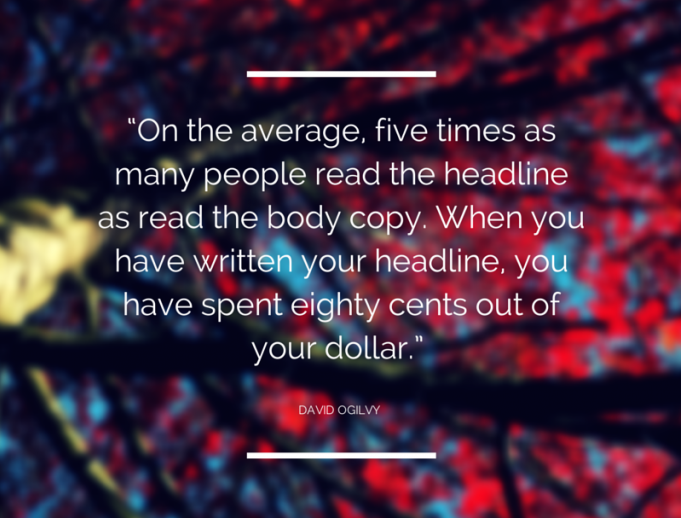Anyone that knows me knows that I am a self-confessed history buff. I love nothing more than soaking up the tales of time gone by, losing myself in romantic notions of kings and knights and damsels in distress, immersing myself in the lives of the Medici family, Da Vinci, Leonardo, Botticelli.
It should come as no surprise then that I am equally as enthralled by the history of my chosen profession. So, I thought it quite fitting to delve into the life of the Father of Advertising, David Ogilvy. He was responsible for some of the most successful and famous campaigns of all times. His approach to advertising, focused on the ‘soft sell’ without interrupting or insulting the intelligence of his audience, was light years ahead of its time; arguably the pre-cursor to today’s content marketing evolution. It is no wonder that we can learn valuable lessons from his campaigns, copywriting, branding, and broad approach to marketing.
Who was David Ogilvy?

Ogilvy’s biography has a somewhat tumultuous beginning. Born in England in 1911, David Mackenzie Ogilvy attended college (but failed to graduate) at Christ Church in Oxford. Rather than finish his education, he departed for Paris, and ended up working as a kitchen hand in the Hotel Majestic. While he have life skills, such as discipline and management, drummed into him at the Majestic, he knew he wasn’t cut out to work there long-term. “If I stayed at the Majestic I would have faced years of slave wages, fiendish pressure, and perpetual exhaustion,” Ogilvy’s been quoted as saying.
Instead, he returned to England to sell Aga Cookers (stoves), door-to-door. And so began his marketing career. He sold stoves to anyone and everyone, to nuns and drunkards, to mothers and grandmothers, to anyone willing to open their front door to him. He was so successful that in 1935, at the age of 24 years old, he penned a comprehensive guide (The Theory and Practice of Selling the Aga Cooker) to selling for Aga’s team of salesmen. More than 30 years after it was published, Fortune Magazine dubbed the guide the best sales manual ever written. Here’s a few little gems I’ve managed to glean from it:

“The worst fault a salesman can commit is to be a bore. Foster any attempt to talk about other things; the longer you stay the better you get to know the prospect, and the more you will be trusted.”
“Avoid standardisation in your sales talk. If you find yourself saying the same things to a bishop and a trapezist, you are done for.”
“The more prospects you talk to, the more sales you expose yourself to, the more orders you will get. But never mistake quantity of calls for quality of salesmanship.”
It was in 1938 that Ogilvy immigrated to the US. There, he landed a job at the Gallup Research Institute; a job that would play a major part in influencing his way of thinking, and attention to detail in research for years to come.
Then World War Two hit. Ogilvy was put to work in the British Intelligence Service in Washington. There he analysed human behaviour, even recommending that Gallup’s techniques should be applied to secret intelligence. Eisenhower’s Psychological Warfare Board picked up the report and successfully put Ogilvy’s suggestions to work in Europe during the last year of the war.
In a complete departure from his previous life, after the war, Ogilvy bought a farm in Pennsylvania, and lived as a farmer among the Amish for several years. Eventually though, he saw the light and shipped his family back to New York: the Ad Man was born.
When, in 1948, Ogilvy founded Hewitt, Ogilvy, Benson & Mather, he had never so much a written an advertisement. But, in the first 20 year’s of his agency’s life, Ogilvy won contracts with some of America’s biggest brands: Lever Brothers, General Foods, American Express, Shell. Sears even hired him for their very first national advertising campaign.
By 1965, Ogilvy had merged with Mather & Crowther, to form a new international company. Just a year later, this international advertising firm was one of the first to go public. While Ogilvy’s story obviously continues past 1965 (he didn’t pass away until 1999), it is these first 20 years in the ad business that I’m going to focus on.
7 Lessons from David Ogilvy on Writing
Given Ogilvy’s global success, achieved almost overnight, there are numerous lessons that can be gleaned from the Father of Advertising; lessons on marketing, on advertising, on business in general. But, I’m going to focus on the 7 lessons he taught us on writing.
1. Your copy should always treat your reader (or customer) with respect.
“A consumer is not a moron. She’s your wife. Don’t insult her intelligence, and don’t shock her.” ~David Ogilvy
Treat your reader, or customer, with respect at all times. Don’t talk down to them, or condescend. It will put them off, immediately. Give them the respect that they deserve, and reflect this in your copy. If anything, you need them more than they need you: after all, you are trying to close a sale.
2. Know your stuff, and demonstrate it in your copy.
“The more informative your advertising, the more persuasive it will be.” ~ David Ogilvy
Fluffy copy is completely ineffective. And, the savvy consumers of the 21st century can spot it from a mile away. So, instead of filling your pages with empty platitudes, pack it with real data. Tell your readers why they should buy your product, why it will solve all their problems, why they should buy from you, and why they should buy right now. Back it all up with data or case studies or demonstrable benefits.
3. Copy is important. Approach it with love and care.
“Like a midwife, I make my living bringing new babies into the world, except that mine are new advertising campaigns.” ~ David Ogilvy
Ask any writer. Copy is just a baby. You plan, and craft, and revise, and redraft, and nurture, and develop. Sometimes for weeks on end. Just to be sure that you have that perfectly crafted opening sentence that captures the mood just so. So, if you’re not a writer by trade, the thought of nurturing copy can seem a little absurd. Scribble a few notes. Check grammar. Done. That’s all you need to do, isn’t it? Taking a little extra love and care with your copy can make all the difference.
4. The headline is all-important.
“On the average, five times as many people read the headline as read the body copy. When you have written your headline, you have spent eighty cents out of your dollar.” ~ David Ogilvy
You only get one chance to convince your readers to keep reading, to care about your message. And, amidst the veritable explosion of content and message delivery channels that compete for reader attention (every minute of every day), crafting a compelling headline is more important than ever.
So, demonstrate to your readers WIIFM (What’s In It For Me). Talk directly to your audience; help them to connect with your content. Think about how your headline looks (all caps = you’re shouting at your readers). Be honest. And be straight to the point. As Ogilvy teaches us, “Never use tricky or irrelevant headlines… People read too fast to figure out what you are trying to say.”
5. Address your readers individually.
“Do not … address your readers as though they were gathered together in a stadium. When people read your copy, they are alone. Pretend you are writing to each of them a letter on behalf of your client.”~ David Ogilvy
Reading is a naturally solitary pursuit (unless you’re reading picture books to the kiddies at bedtime). Keep this is mind when it comes to crafting your copy. It’s not necessarily a one-size-fits-all output. You may need to craft slightly different (or even entirely different) messages for particularly niche markets. Let’s take a new brand of make-up as an example. While the target market could be as broad as ‘All women over the age of sixteen’, you will need different copy for different niche markets within that demographic. Sixteen-year-old schoolgirls will not be convinced to buy with the same copy as 35 year old stay-at-home-mums.
6. Write like you speak.
“If you’re trying to persuade people to do something, or buy something, it seems to me you should use their language, the language they use every day, the language in which they think. We try to write in the vernacular.”~ David Ogilvy
The most effective copy is simple. It doesn’t contain big, long, complicated words. Effective copy employs short words, short sentences, short paragraphs. Small, easily digestible chunks. No one wants to have pull out the dictionary just to navigate through your jargon. Keep it simple. Write as if you are talking directly to your readers.
7. When it comes down it, sometimes you just have to lock yourself away and write.
“If you have all the research, all the ground rules, all the directives, all the data — it doesn’t mean the ad is written. Then you’ve got to close the door and write something — that is the moment of truth which we all try to postpone as long as possible.”
Writing takes time, and energy, and concentration. Even if you have all the research, and market data in the world, you still need to get it all out of your head (or out of your reports) and onto the page. Some days, you just have to lock yourself away and start tapping out the words.
To close, consider this memo that Ogilvy sent to one of his partners at the height of his success…
Will Any Agency Hire This Man?
- He is 38, and unemployed. He dropped out of college.
- He has been a cook, a salesman, a diplomatist and a farmer.
- He knows nothing about marketing and has never written any copy.
- He professes to be interested in advertising as a career (at the age of 38!) and is ready to go to work for $5,000 a year.
- Luckily, an agency did hire him. And, just three years later, Ogilvy was the most famous copywriter ever, who would go on to build one of the biggest ad agencies in the world.
The moral of the Ogilvy story: sometimes it pays to be imaginative, offbeat, and unorthodox in hiring.
Sources:
- http://www.ogilvy.com/About/Our-History/David-Ogilvy-Bio.aspx
- http://www.lannigan.org/the_theory%20and_practice_of_selling_the_aga_cooker_training_manual.htm
- http://www.copyblogger.com/lessons-from-david-ogilvy/
- https://blog.kissmetrics.com/david-ogilvy/




